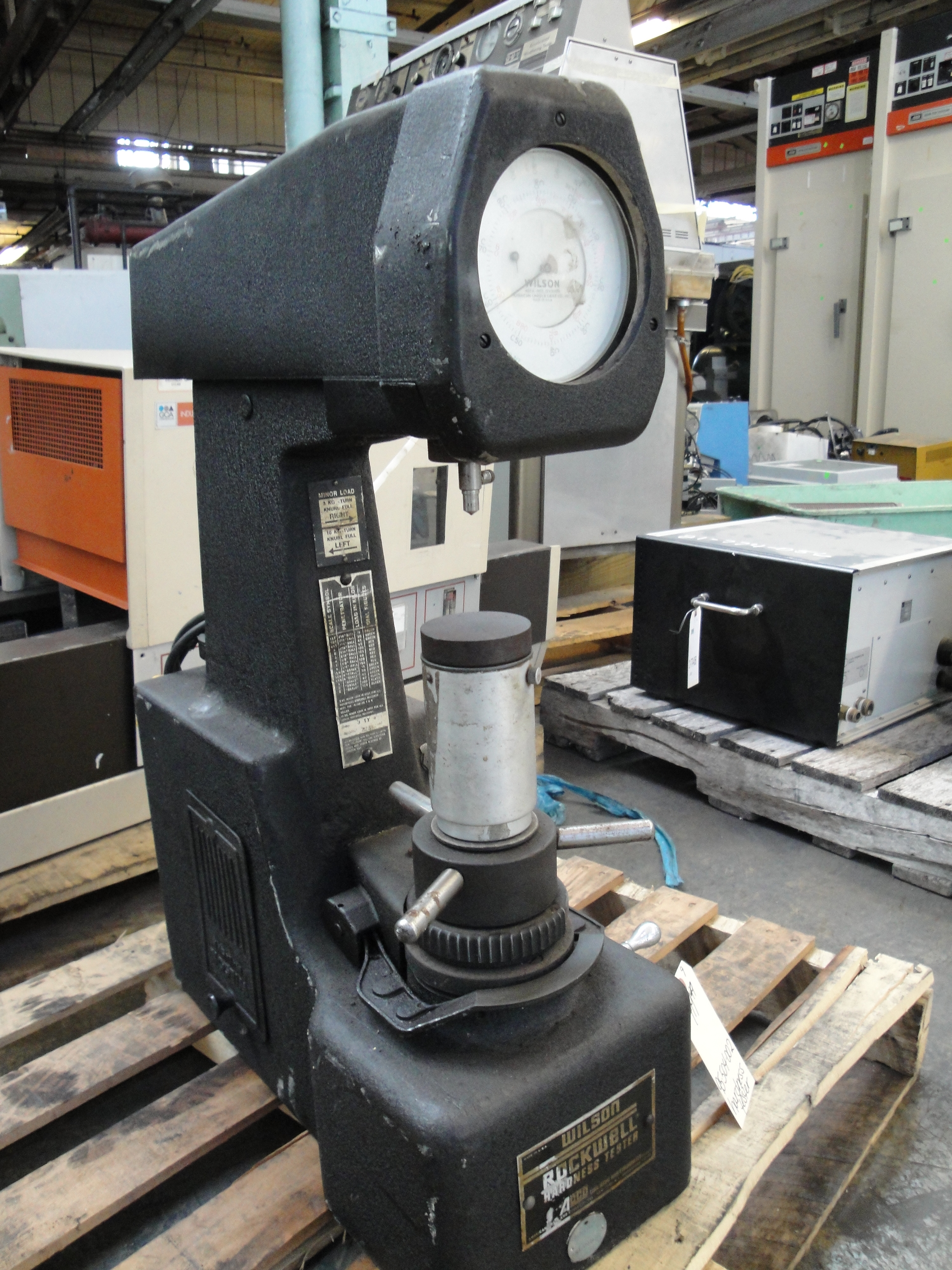|
Brinell
The Brinell hardness test (pronounced /brəˈnɛl/) measures the indentation hardness of materials. It determines hardness through the scale of penetration of an indenter, loaded on a material test-piece. It is one of several definitions of hardness in materials science. The hardness scale is expressed in terms of a Brinell hardness value, sometimes referred to as the Brinell hardness number but formally expressed as HBW (Hardness Brinell Wolfram – Wolfram being an alternative name for the tungsten carbide ball indenter used during the test). The test was named after Johan August Brinell (1849-1925) who developed the method at the end of the 19th century. History Premiered by Swedish engineer Johan August Brinell at the 1900 Paris Exposition, it was the first widely used and standardised hardness test in engineering and metallurgy. The large size of indentation and thus possible damage to test-pieces limits its usefulness. However, it also had the useful feature that the h ... [...More Info...] [...Related Items...] OR: [Wikipedia] [Google] [Baidu] |
Johan August Brinell
August Brinell (10 October 1849 – 17 November 1925) was a Swedish metallurgical engineer. Brinell is noted as the creator of a method for quantifying the surface hardness of materials, now known as the Brinell hardness test. His name is also commemorated in the description of a failure mechanism of material surfaces known as Brinelling. Biography Brinell was born in Bringetofta, Nässjö Kommun, Sweden. He began his career as an Engineer at the Lesjöfors Ironworks and in 1882 became chief engineer at the Fagersta Ironworks. In 1903 he became Chief Engineer at Jernkontoret, the Swedish Ironmasters' Association. He remained at that post until 1914. Brinell was elected a member of the Royal Swedish Academy of Sciences in 1902, and of the Royal Swedish Academy of Engineering Sciences in 1919. He was awarded the Bessemer Gold Medal of the Iron and Steel Institute in 1907. He died of pneumonia in 1925 in Stockholm. Legacy Brinell is best known today for the Brinell har ... [...More Info...] [...Related Items...] OR: [Wikipedia] [Google] [Baidu] |
Hardness Comparison
A variety of hardness-testing methods are available, including the Vickers, Brinell, Rockwell, Meyer and Leeb tests. Although it is impossible in many cases to give an exact conversion, it is possible to give an approximate material-specific comparison table for steels. Hardness comparison table {, class="wikitable" ! Brinell HB (10 mm Ball, 3000 kg load)!!Vickers Vickers was a British engineering company that existed from 1828 until 1999. It was formed in Sheffield as a steel foundry by Edward Vickers and his father-in-law, and soon became famous for casting church bells. The company went public in 18 ... HV (5 kg)!! Rockwell C HRC (120 degree cone 150 kg)!!Rockwell B HRB (1/16" ball 100 kg)!! Leeb HLDH.Pollok, „Umwertung der Skalen“ (“Conversion of Scales”), Qualität und Zuverlässigkeit, Ausgabe 4/2008. , - , 800, , -, , 72, , -, , 856 , - , 780, , 1220, , 71, , -, , 850 , - , 760, , 1210, , 70, , -, , 843 , - , 745, , 1114, , 68 ... [...More Info...] [...Related Items...] OR: [Wikipedia] [Google] [Baidu] |
Brinelling
Brinelling is the permanent indentation of a hard surface. It is named after the Brinell scale of hardness, in which a small ball is pushed against a hard surface at a preset level of force, and the depth and diameter of the mark indicates the Brinell hardness of the surface. Brinelling is permanent plastic deformation of a surface, and usually occurs while two surfaces in contact are stationary (such as rolling elements and the raceway of a bearing) and the material yield strength has been exceeded. Brinelling is undesirable, as the parts often mate with other parts in very close proximity. The very small indentations can quickly lead to improper operation, such as chattering or excess vibration, which in turn can accelerate other forms of wear, such as spalling and ultimately, failure of the bearing. Introduction Brinelling is a material surface failure caused by Hertz contact stress that exceeds the material limit. It usually occurs in situations where a significant load fo ... [...More Info...] [...Related Items...] OR: [Wikipedia] [Google] [Baidu] |
Leeb Rebound Hardness Test
The Leeb Rebound Hardness Test (LRHT) invented by Swiss company Proceq SA is one of the four most used methods for testing metal hardness. This portable method is mainly used for testing sufficiently large workpieces (mainly above 1 kg). It measures the coefficient of restitution. It is a form of nondestructive testing. History The Equotip (later on also called simultaneously as Leeb method) rebound hardness test method was developed in the year 1975 by Leeb and Brandestini at Proceq SA to provide a portable hardness test for metals. It was developed as an alternative to the unwieldy and sometimes intricate traditional hardness measuring equipment. The first Leeb rebound product on the market was named “Equotip”, a phrase that still is used synonymously with “Leeb rebound” due to the wide circulation of the “Equotip” product. Traditional hardness measurements, ''e.g.'', those of Rockwell, Vickers, and Brinell, are stationary, requiring fixed workstations in seg ... [...More Info...] [...Related Items...] OR: [Wikipedia] [Google] [Baidu] |
Rockwell Hardness Test
The Rockwell hardness test is a hardness test based on indentation hardness of a material. The Rockwell test measures the depth of penetration of an indenter under a large load (major load) compared to the penetration made by a preload (minor load). There are different scales, denoted by a single letter, that use different loads or indenters. The result is a dimensionless number noted as HRA, HRB, HRC, etc., where the last letter is the respective Rockwell scale. Larger numbers correspond to harder materials. When testing metals, indentation hardness correlates linearly with tensile strength. History The differential depth hardness measurement was conceived in 1908 by Viennese professor Paul Ludwik in his book ''Die Kegelprobe'' (crudely, "the cone test"). The differential-depth method subtracted out the errors associated with the mechanical imperfections of the system, such as backlash and surface imperfections. The Brinell hardness test, invented in Sweden, was developed ea ... [...More Info...] [...Related Items...] OR: [Wikipedia] [Google] [Baidu] |
Metallurgy
Metallurgy is a domain of materials science and engineering that studies the physical and chemical behavior of metallic elements, their inter-metallic compounds, and their mixtures, which are known as alloys. Metallurgy encompasses both the science and the technology of metals, including the production of metals and the engineering of metal components used in products for both consumers and manufacturers. Metallurgy is distinct from the craft of metalworking. Metalworking relies on metallurgy in a similar manner to how medicine relies on medical science for technical advancement. A specialist practitioner of metallurgy is known as a metallurgist. The science of metallurgy is further subdivided into two broad categories: chemical metallurgy and physical metallurgy. Chemical metallurgy is chiefly concerned with the reduction and oxidation of metals, and the chemical performance of metals. Subjects of study in chemical metallurgy include mineral processing, the extraction ... [...More Info...] [...Related Items...] OR: [Wikipedia] [Google] [Baidu] |
Meyer's Law
Meyer's law is an empirical relation between the size of a hardness test indentation and the load required to leave the indentation.. The formula was devised by Eugene Meyer of the Materials Testing Laboratory at the Imperial School of Technology, Charlottenburg, Germany, circa 1908. Equation It takes the form: :P\,=\,kd^n where *''P'' is the pressure in megapascals *''k'' is the resistance of the material to initial penetrationS.L. Hoyt, "The Ball Indentation Hardness Test," ''Trans. Am. Soc. Steel Treating'', 6 (1924). *''n'' is Meyer's index, a measure of the effect of the deformation on the hardness of the material *''d'' is the chordal diameter (diameter of the indentation) The index ''n'' usually lies between the values of 2, for fully strain hardened materials, and 2.5, for fully annealed materials. It is roughly related to the strain hardening coefficient in the equation for the true stress-true strain curve by adding 2. Note, however, that below approximately ''d'' ... [...More Info...] [...Related Items...] OR: [Wikipedia] [Google] [Baidu] |
Hardwood
Hardwood is wood from Flowering plant, angiosperm trees. These are usually found in broad-leaved temperate and tropical forests. In temperate and boreal ecosystem, boreal latitudes they are mostly deciduous, but in tropics and subtropics mostly evergreen. Hardwood (which comes from angiosperm trees) contrasts with softwood (which is from gymnosperm trees). Characteristics Hardwoods are produced by Flowering plant, angiosperm trees that reproduce by flowers, and have broad leaves. Many species are deciduous. Those of temperate regions lose their leaves every autumn as temperatures fall and are dormant in the winter, but those of tropical regions may shed their leaves in response to seasonal or sporadic periods of drought. Hardwood from deciduous species, such as oak, normally shows annual dendrochronology, growth rings, but these may be absent in some tropical timber, tropical hardwoods. Hardwoods have a more complex structure than softwoods and are often much slower growing ... [...More Info...] [...Related Items...] OR: [Wikipedia] [Google] [Baidu] |
Softwood
Scots pine, a typical and well-known softwood Softwood is wood from gymnosperm trees such as conifers. The term is opposed to hardwood, which is the wood from angiosperm trees. The main differences between hardwoods and softwoods is that the softwoods completely lack vessels (pores). The main softwood species (pines, spruces, larches, false tsugas) also have resin canals (or ducts) in their structure. Characteristics Softwood is wood from gymnosperm trees such as pines and spruces. Softwoods are not necessarily softer than hardwoods. The hardest hardwoods are much harder than any softwood, but in both groups there is enormous variation with the range of wood hardness of the two groups overlapping. For example, balsa wood, which is a hardwood, is softer than most softwoods, whereas the longleaf pine, Douglas fir, and yew softwoods are much harder than several hardwoods. Several specific natural, macroscopic and microscopic features of wood are used in the identification p ... [...More Info...] [...Related Items...] OR: [Wikipedia] [Google] [Baidu] |
Glass
Glass is an amorphous (non-crystalline solid, non-crystalline) solid. Because it is often transparency and translucency, transparent and chemically inert, glass has found widespread practical, technological, and decorative use in window panes, tableware, and optics. Some common objects made of glass are named after the material, e.g., a Tumbler (glass), "glass" for drinking, "glasses" for vision correction, and a "magnifying glass". Glass is most often formed by rapid cooling (quenching) of the Melting, molten form. Some glasses such as volcanic glass are naturally occurring, and obsidian has been used to make arrowheads and knives since the Stone Age. Archaeological evidence suggests glassmaking dates back to at least 3600 BC in Mesopotamia, Ancient Egypt, Egypt, or Syria. The earliest known glass objects were beads, perhaps created accidentally during metalworking or the production of faience, which is a form of pottery using lead glazes. Due to its ease of formability int ... [...More Info...] [...Related Items...] OR: [Wikipedia] [Google] [Baidu] |
Rhenium Diboride
Rhenium diboride (ReB2) is a synthetic high-hardness material that was first synthesized in 1962. The compound is formed from a mixture of rhenium, noted for its resistance to high pressure, and boron, which forms short, strong covalent bonds with rhenium. It has regained popularity in recent times in hopes of finding a material that possesses hardness comparable to that of diamond. Unlike other high-hardness synthetic materials, such as the c-BN, rhenium diboride can be synthesized at ambient pressure, potentially simplifying a mass production. However, the high cost of rhenium and commercial availability of alternatives such as polycrystalline c-BN, make a prospect of large-scale applications less likely. Synthesis ReB2 can be synthesized by at least three different methods at standard atmospheric pressure: solid-state metathesis, melting in an electric arc, and direct heating of the elements. In the metathesis reaction, rhenium trichloride and magnesium diboride ar ... [...More Info...] [...Related Items...] OR: [Wikipedia] [Google] [Baidu] |



